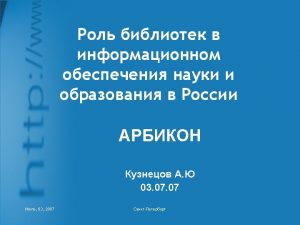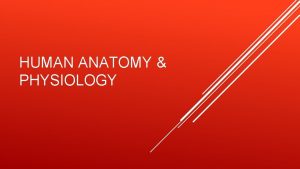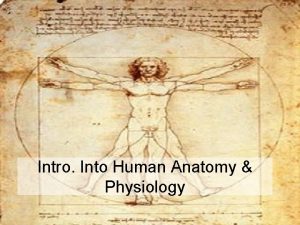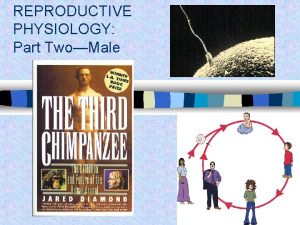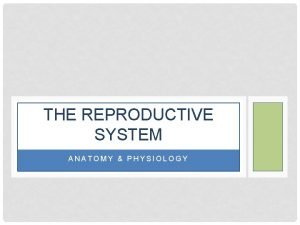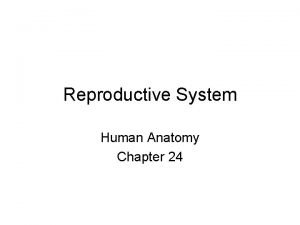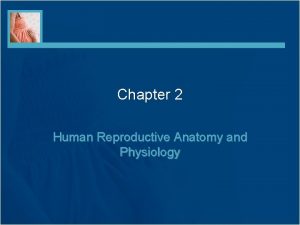Chapter 2 Human Reproductive Anatomy and Physiology Elsevier






































- Slides: 38

Chapter 2 Human Reproductive Anatomy and Physiology Elsevier items and derived items © 2015, 2011, 2007, 2006 by Saunders, an imprint of Elsevier Inc.

Puberty (p. 20) Involves changes in the whole body and psyche Reproductive system matures and becomes capable of reproduction Secondary sex characteristics appear Ends when Ø Ø Mature sperm are formed in males Menstrual cycles become regular in females Elsevier items and derived items © 2015, 2011, 2007, 2006 by Saunders, an imprint of Elsevier Inc. 2

Puberty (cont. ) (pp. 20 -21) Celebrated in many cultures as a rite of passage into adulthood Other cultures lack this ritual Ø Has led to confusion for some adolescents in many industrialized nations Elsevier items and derived items © 2015, 2011, 2007, 2006 by Saunders, an imprint of Elsevier Inc. 3

Male Reproductive System (p. 20 -22) Elsevier items and derived items © 2015, 2011, 2007, 2006 by Saunders, an imprint of Elsevier Inc. 4

The Male (p. 21) Hormonal changes begin between 10 and 16 years of age Outward changes Ø Ø Ø Penis and testes increase in size Grows taller, more muscular Secondary sex characteristics • Pubic and facial hair • Deeper voice Testosterone levels become constant Nocturnal emissions (“wet dreams”) may occur They do not contain sperm Elsevier items and derived items © 2015, 2011, 2007, 2006 by Saunders, an imprint of Elsevier Inc. 5

External Genitalia (p. 21) Penis Ø Ø Expels urine from bladder Deposits sperm into female’s vagina Contains erectile tissue Blood is trapped within the spongy erectile tissue to enable erection Scrotum Ø Ø Sac that contains the testes Suspended from the perineum Helps keeps testes cooler than the rest of the body Necessary for spermatogenesis Elsevier items and derived items © 2015, 2011, 2007, 2006 by Saunders, an imprint of Elsevier Inc. 6

Internal Genitalia (pp. 21 -22) Testes Ø Manufacture male germ cells Spermatozoa or sperm Ø Secrete male hormones • Androgens Elsevier items and derived items © 2015, 2011, 2007, 2006 by Saunders, an imprint of Elsevier Inc. 7

Testosterone (p. 22) Has the following effects, not related to sexual reproduction Ø Ø Ø Increases muscle mass and strength Promotes growth of long bones Increases basal metabolic rate (BMR) Enhances production of RBCs Produces enlargement of vocal cords Affects the distribution of body hair Elsevier items and derived items © 2015, 2011, 2007, 2006 by Saunders, an imprint of Elsevier Inc. 8

Ducts (p. 22) Epididymis Ø Ø Stores sperm for 2 to 10 days Ø One from each testicle Stores and carries sperm to the penis Sperm mature and then move to the vas deferens The urethra transports both urine (from the bladder) and semen (from the prostate) to be expelled Ø But not at the same time Elsevier items and derived items © 2015, 2011, 2007, 2006 by Saunders, an imprint of Elsevier Inc. 9

Accessory Glands (p. 22) Seminal vesicles Prostate gland Bulbourethral glands (a. k. a. Cowper’s glands) Job is to produce secretions to Ø Ø Ø Nourish sperm Protect sperm from acidic environment within woman’s vagina Enhance motility of sperm Semen is seminal plasma and sperm together Elsevier items and derived items © 2015, 2011, 2007, 2006 by Saunders, an imprint of Elsevier Inc. 10

Female Reproductive System (pp. 22 -28) Elsevier items and derived items © 2015, 2011, 2007, 2006 by Saunders, an imprint of Elsevier Inc. 11

External Genitalia (pp. 22 -23) Collectively called the vulva Ø Includes • • Mons pubis Labia majora Labia minora Fourchette Clitoris Vaginal vestibule Perineum Elsevier items and derived items © 2015, 2011, 2007, 2006 by Saunders, an imprint of Elsevier Inc. 12

External Genitalia (cont. ) (pp. 22 -23) Mons pubis Ø Ø Labia majora Ø Ø Pad of fat tissue covered by coarse skin and pubic hair Protects symphysis pubis Two folds of fatty tissue on each side of vaginal vestibule Many small glands in this area Labia minora Ø Two thin, soft folds of tissue • Secretions from sebaceous glands Bactericidal Lubricate and protect the skin of the vulva Elsevier items and derived items © 2015, 2011, 2007, 2006 by Saunders, an imprint of Elsevier Inc. 13

External Genitalia (cont. ) (pp. 22 -23) Fourchette Ø Ø Fold of tissue just below vagina Known as obstetrical perineum Clitoris Ø Ø Erectile body Most sensitive part of female genitalia, produces smegma (a cheese-like secretion of sebaceous glands) Elsevier items and derived items © 2015, 2011, 2007, 2006 by Saunders, an imprint of Elsevier Inc. 14

External Genitalia (cont. ) (pp. 22 -23) Vaginal vestibule Ø Ø Ø Urethral meatus—exit for urine Skene’s ducts—lubricate urethra and vaginal orifice Vaginal introitus—divides the external and internal genitalia Hymen—thin elastic membrane that closes vagina from vestibule Ducts of Bartholin’s glands—lubricate introitus during sexual arousal, not normally visible Perineum Ø Ø Ø Strong muscular area between vaginal opening and anus Allows stretching for birth Site of episiotomy Elsevier items and derived items © 2015, 2011, 2007, 2006 by Saunders, an imprint of Elsevier Inc. 15

Vagina (p. 23) Tubular structure Ø Ø Rugae Ø Ø Enables stretching during sexual intercourse Delivery of fetus Self-cleansing Ø Muscle and membranous tissue Connects external genitalia to uterus During reproductive years, p. H 4 to 5 Functions Ø Ø Ø Provides passageway for sperm to enter the uterus Allows drainage of menstrual fluids and other secretions Provides a passageway for delivery of fetus Elsevier items and derived items © 2015, 2011, 2007, 2006 by Saunders, an imprint of Elsevier Inc. 16

Side View of the Internal Female Reproductive Organs (p. 23) Elsevier items and derived items © 2015, 2011, 2007, 2006 by Saunders, an imprint of Elsevier Inc. 17

Uterus (pp. 23 -24) Hollow muscular organ Ø Shaped like an upside-down pear Lies between the urinary bladder and rectum, above the vagina Supported by the following ligaments Ø Ø Fertilized ovum implants and develops into an embryo Broad Round Cardinal Uterosacral Autonomic nerve supply Not under voluntary or conscious control Various motor and nerve roots supply sensation to the uterus Ø Important in pain management during labor Elsevier items and derived items © 2015, 2011, 2007, 2006 by Saunders, an imprint of Elsevier Inc. 18

Uterus (cont. ) (pp. 23 -24) Fundus and corpus (body of the uterus) Ø Have three distinct layers • Perimetrium • Myometrium • Endometrium—governed by cyclical hormonal changes Elsevier items and derived items © 2015, 2011, 2007, 2006 by Saunders, an imprint of Elsevier Inc. 19

Uterus (cont. ) (pp. 23 -24) Cervix (neck or lower part of uterus) Consists of cervical canal with an internal opening near uterine corpus (internal os) Opening into vagina (external os) Mucosal lining has four functions Ø Ø Lubricates vagina Acts as a bacteriostatic agent Provides alkaline environment to shelter deposited sperm Produces a mucus plug in cervical canal during pregnancy Elsevier items and derived items © 2015, 2011, 2007, 2006 by Saunders, an imprint of Elsevier Inc. 20

Fallopian Tubes (p. 25) Four sections Ø Ø Interstitial Isthmus Ampulla Infundibulum • Fingerlike projections called fimbriae capture the ovum (egg) as it is released from the ovary Four functions Ø Ø Passageway for sperm to meet the ovum Site of fertilization Safe, nourishing environment for the ovum or zygote (fertilized ovum) Means of transporting ovum or zygote to the corpus of the uterus Elsevier items and derived items © 2015, 2011, 2007, 2006 by Saunders, an imprint of Elsevier Inc. 21

Ovaries (p. 25) Almond-shaped Size of a walnut Held in place by ovarian and uterine ligaments Two functions Ø Production of hormones • Mainly estrogen and progesterone Ø Stimulate maturation of an ovum during each reproductive cycle Elsevier items and derived items © 2015, 2011, 2007, 2006 by Saunders, an imprint of Elsevier Inc. 22

Ovaries (cont. ) (p. 25) At birth, every female has all the ova that she will have throughout her reproductive years (around 2 million) By adulthood, number of ova is in the thousands By climacteric (menopause), the ova no longer mature in response to hormonal stimulation Elsevier items and derived items © 2015, 2011, 2007, 2006 by Saunders, an imprint of Elsevier Inc. 23

Functions of the Bony Pelvis (pp. 25 -26) Parts Ø Two innominate bones, sacrum, and coccyx Support and distribute body weight Support and protect pelvic organs Form the birth passageway Elsevier items and derived items © 2015, 2011, 2007, 2006 by Saunders, an imprint of Elsevier Inc. 24

Types of Female Pelves (pp. 25 -26) Gynecoid most favorable for vaginal delivery Platypelloid is unfavorable for vaginal delivery Elsevier items and derived items © 2015, 2011, 2007, 2006 by Saunders, an imprint of Elsevier Inc. 25

True and False Pelves (p. 26) Separated by an imaginary line, the linea terminalis False pelvis Ø Ø Supports the enlarging uterus Guides fetus into true pelvis True pelvis Ø Dictates the bony limits of the birth canal Elsevier items and derived items © 2015, 2011, 2007, 2006 by Saunders, an imprint of Elsevier Inc. 26

Pelvic Inlet (p. 26) Diagonal conjugate Ø Obstetric conjugate (smallest diameter) Ø Assessed during a manual exam Determines if the fetus can pass through the birth canal Transverse diameter (largest diameter) Ø Determines the inlet’s shape Elsevier items and derived items © 2015, 2011, 2007, 2006 by Saunders, an imprint of Elsevier Inc. 27

Important Pelvic Inlet Diameters (p. 26) Elsevier items and derived items © 2015, 2011, 2007, 2006 by Saunders, an imprint of Elsevier Inc. 28

Pelvic Outlet (p. 26) Coccyx can move or break during passage of fetal head Immobile coccyx can decrease the size of the pelvic outlet Ø Can make vaginal birth difficult Adequate pelvic measurements are essential for successful vaginal birth Elsevier items and derived items © 2015, 2011, 2007, 2006 by Saunders, an imprint of Elsevier Inc. 29

Breasts (cont. ) (p. 27) Accessory organs of reproduction Ø Produce milk after birth • Provides nourishment for the infant • Provides maternal antibodies to infant Montgomery’s glands Ø Ø Small sebaceous glands Secrete a substance to lubricate and protect breasts during lactation Elsevier items and derived items © 2015, 2011, 2007, 2006 by Saunders, an imprint of Elsevier Inc. 30

Breasts (p. 27) Elsevier items and derived items © 2015, 2011, 2007, 2006 by Saunders, an imprint of Elsevier Inc. 31

Reproductive and Menstruation Cycle (p. 27) Cycle consists of regular changes in secretions of the anterior pituitary gland, ovary, and endometrial lining of uterus FSH and LH stimulate maturation of ovarian follicle Ø Maturing ovum and corpus luteum produce increased amount of estrogen and progesterone Surge of LH stimulates final maturation Ø Release of ovum Elsevier items and derived items © 2015, 2011, 2007, 2006 by Saunders, an imprint of Elsevier Inc. 32

Reproductive Cycle and Menstruation (p. 27) Development of breasts occurs first First menstrual period (menarche) occurs approximately 2 to 2. 5 years later (around 11 to 15 years of age) Growth spurt ends earlier than the male Hips broaden Pubic and axillary hair appear Elsevier items and derived items © 2015, 2011, 2007, 2006 by Saunders, an imprint of Elsevier Inc. 33

Female Reproductive Cycle (cont. ) (pp. 27 -28) Ovulation Ø Ø Ø Corpus luteum degenerates if the ova is not fertilized Ø Ø Ø Mature ovum released from follicle about 14 days before onset of menstrual period Corpus luteum turns yellow Secretes increased quantities of progesterone Progesterone and estrogen levels decrease Causes endometrium to break down Results in menstruation New cycle begins again Elsevier items and derived items © 2015, 2011, 2007, 2006 by Saunders, an imprint of Elsevier Inc. 34

Physiology of the Male Sex Act (p. 29) Massaging action of intercourse stimulates nerves Ø Ø Ø Parasympathetic: relaxation of penile arteries leads to increased blood flow to shaft (erection) Urethral glands secrete mucus to aid in lubrication for sperm motility Rhythmic contraction of penile erectile tissues, urethra, and skeletal muscles leads to expulsion of semen (ejaculation) Elsevier items and derived items © 2015, 2011, 2007, 2006 by Saunders, an imprint of Elsevier Inc. 35

Physiology of the Male Sex Act (cont. ) (p. 29) After orgasm (resolution) Ø Ø Erection ceases Cavernous sinuses empty Arteries contract Penis becomes flaccid Sperm can reach fallopian tubes within 5 minutes Ø Can remain viable in female for up to 4 to 5 days Elsevier items and derived items © 2015, 2011, 2007, 2006 by Saunders, an imprint of Elsevier Inc. 36

Physiology of Female Sex Act (p. 29) Female psyche can initiate or inhibit sexual response Local stimulation of breasts, vulva, vagina, and perineum increases sexual sensations Ø Ø Ø Parasympathetic nerves signal erectile tissue around vaginal introitus Dilation and filling of arteries leads to tightening of vagina around penis Stimulates Bartholin’s glands to secrete mucus (aids in vaginal lubrication) Elsevier items and derived items © 2015, 2011, 2007, 2006 by Saunders, an imprint of Elsevier Inc. 37

Physiology of Female Sex Act (cont. ) (p. 29) Posterior pituitary gland secretes oxytocin Ø Stimulates contraction of uterus and dilation of cervical canal Orgasm believed to aid in transport of sperm into fallopian tubes Ø Ø Egg lives 24 hours after ovulation Sperm must be available during that time for fertilization to occur Elsevier items and derived items © 2015, 2011, 2007, 2006 by Saunders, an imprint of Elsevier Inc. 38
 Chapter 2 human reproductive anatomy and physiology
Chapter 2 human reproductive anatomy and physiology Chapter 1 introduction to human anatomy and physiology
Chapter 1 introduction to human anatomy and physiology Medial lateral distal proximal
Medial lateral distal proximal Endomysium
Endomysium Holes essential of human anatomy and physiology
Holes essential of human anatomy and physiology Uterus perimetrium
Uterus perimetrium Anatomy and physiology edition 9
Anatomy and physiology edition 9 Chapter 14 anatomy and physiology
Chapter 14 anatomy and physiology Anatomy and physiology chapter 8 special senses
Anatomy and physiology chapter 8 special senses Chapter 13 anatomy and physiology of pregnancy
Chapter 13 anatomy and physiology of pregnancy Chapter 2 basic chemistry anatomy and physiology
Chapter 2 basic chemistry anatomy and physiology Chapter 7:9 lymphatic system
Chapter 7:9 lymphatic system Anatomy and physiology coloring workbook figure 14-1
Anatomy and physiology coloring workbook figure 14-1 Chapter 10 blood anatomy and physiology
Chapter 10 blood anatomy and physiology Anatomy and physiology chapter 15
Anatomy and physiology chapter 15 Necessary life functions anatomy and physiology
Necessary life functions anatomy and physiology Holes anatomy and physiology chapter 1
Holes anatomy and physiology chapter 1 Anatomy and physiology chapter 15
Anatomy and physiology chapter 15 Appendicular skeleton pectoral girdle
Appendicular skeleton pectoral girdle Chapter 6 general anatomy and physiology
Chapter 6 general anatomy and physiology Cephalic cranial
Cephalic cranial Reproductive physiology
Reproductive physiology Lower respiratory tract
Lower respiratory tract Tattoo anatomy and physiology
Tattoo anatomy and physiology Anatomy science olympiad
Anatomy science olympiad Crown plants examples
Crown plants examples Anatomy and physiology of bone
Anatomy and physiology of bone Pud
Pud Liver anatomy
Liver anatomy Podbřišek
Podbřišek Hypogastric region
Hypogastric region Google
Google Http://anatomy and physiology
Http://anatomy and physiology Physiology of appendicitis
Physiology of appendicitis Aohs foundations of anatomy and physiology 1
Aohs foundations of anatomy and physiology 1 Aohs foundations of anatomy and physiology 2
Aohs foundations of anatomy and physiology 2 Anatomy and physiology of swine
Anatomy and physiology of swine Teks anatomy and physiology
Teks anatomy and physiology Science olympiad anatomy and physiology 2020 cheat sheet
Science olympiad anatomy and physiology 2020 cheat sheet









































